International Marketing: Strategies, Scope, and Coca-Cola Analysis
VerifiedAdded on 2023/01/12
|8
|1823
|64
Report
AI Summary
This report provides a comprehensive analysis of international marketing, using Coca-Cola as a case study. It begins with an introduction to international marketing, defining its scope and key concepts. The report then explores Coca-Cola's rationale for internationalization and various market entry routes, including franchising and licensing. It evaluates the criteria and selection processes for entering new international markets, as well as various market entry strategies with their advantages and disadvantages. The discussion extends to the global versus local marketing debate, examining how product, pricing, promotional, and distribution approaches differ in various international contexts. The report concludes with a summary of key findings and references.

International
Marketing
Marketing
Paraphrase This Document
Need a fresh take? Get an instant paraphrase of this document with our AI Paraphraser
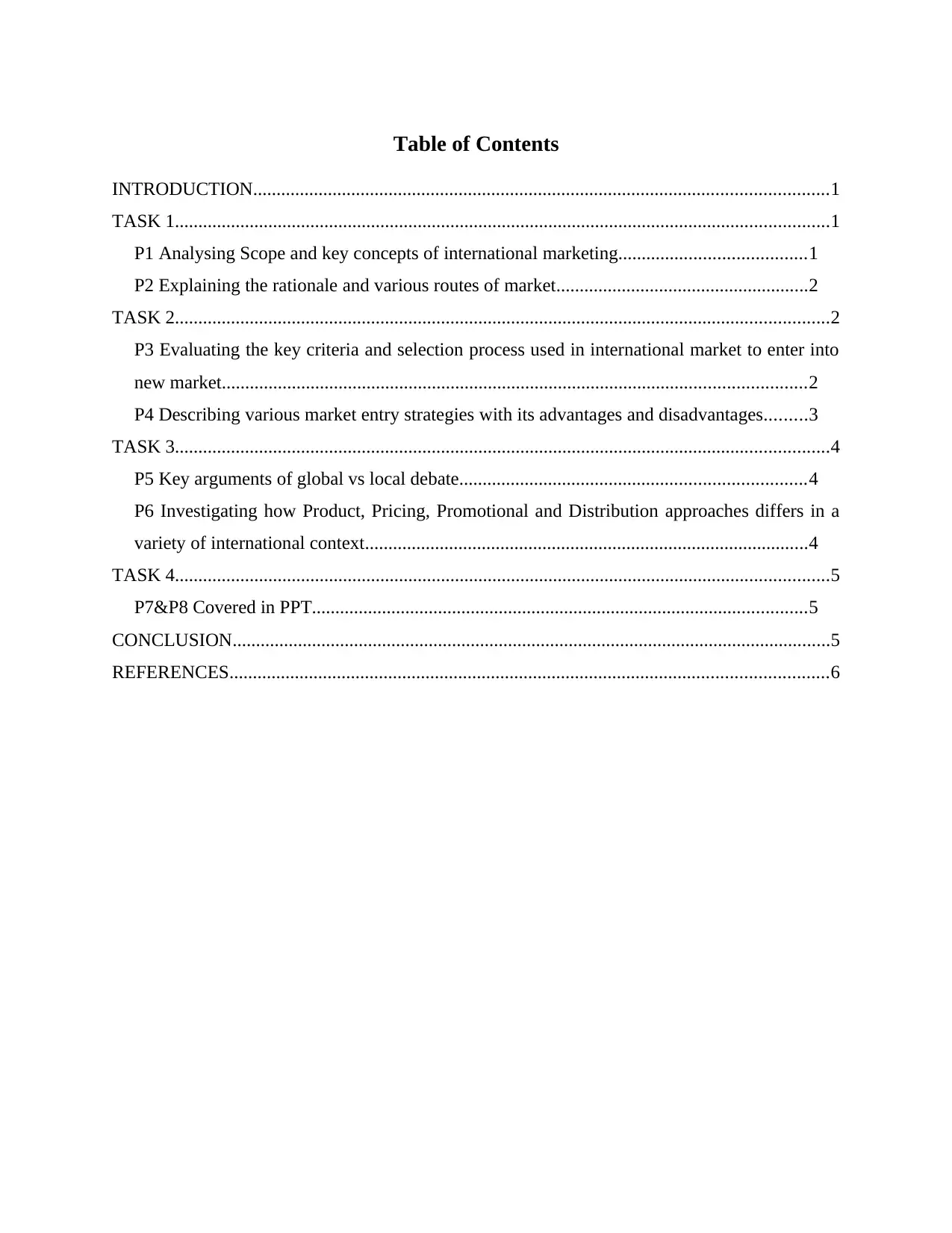
Table of Contents
INTRODUCTION...........................................................................................................................1
TASK 1............................................................................................................................................1
P1 Analysing Scope and key concepts of international marketing........................................1
P2 Explaining the rationale and various routes of market......................................................2
TASK 2............................................................................................................................................2
P3 Evaluating the key criteria and selection process used in international market to enter into
new market.............................................................................................................................2
P4 Describing various market entry strategies with its advantages and disadvantages.........3
TASK 3............................................................................................................................................4
P5 Key arguments of global vs local debate..........................................................................4
P6 Investigating how Product, Pricing, Promotional and Distribution approaches differs in a
variety of international context...............................................................................................4
TASK 4............................................................................................................................................5
P7&P8 Covered in PPT..........................................................................................................5
CONCLUSION................................................................................................................................5
REFERENCES................................................................................................................................6
INTRODUCTION...........................................................................................................................1
TASK 1............................................................................................................................................1
P1 Analysing Scope and key concepts of international marketing........................................1
P2 Explaining the rationale and various routes of market......................................................2
TASK 2............................................................................................................................................2
P3 Evaluating the key criteria and selection process used in international market to enter into
new market.............................................................................................................................2
P4 Describing various market entry strategies with its advantages and disadvantages.........3
TASK 3............................................................................................................................................4
P5 Key arguments of global vs local debate..........................................................................4
P6 Investigating how Product, Pricing, Promotional and Distribution approaches differs in a
variety of international context...............................................................................................4
TASK 4............................................................................................................................................5
P7&P8 Covered in PPT..........................................................................................................5
CONCLUSION................................................................................................................................5
REFERENCES................................................................................................................................6
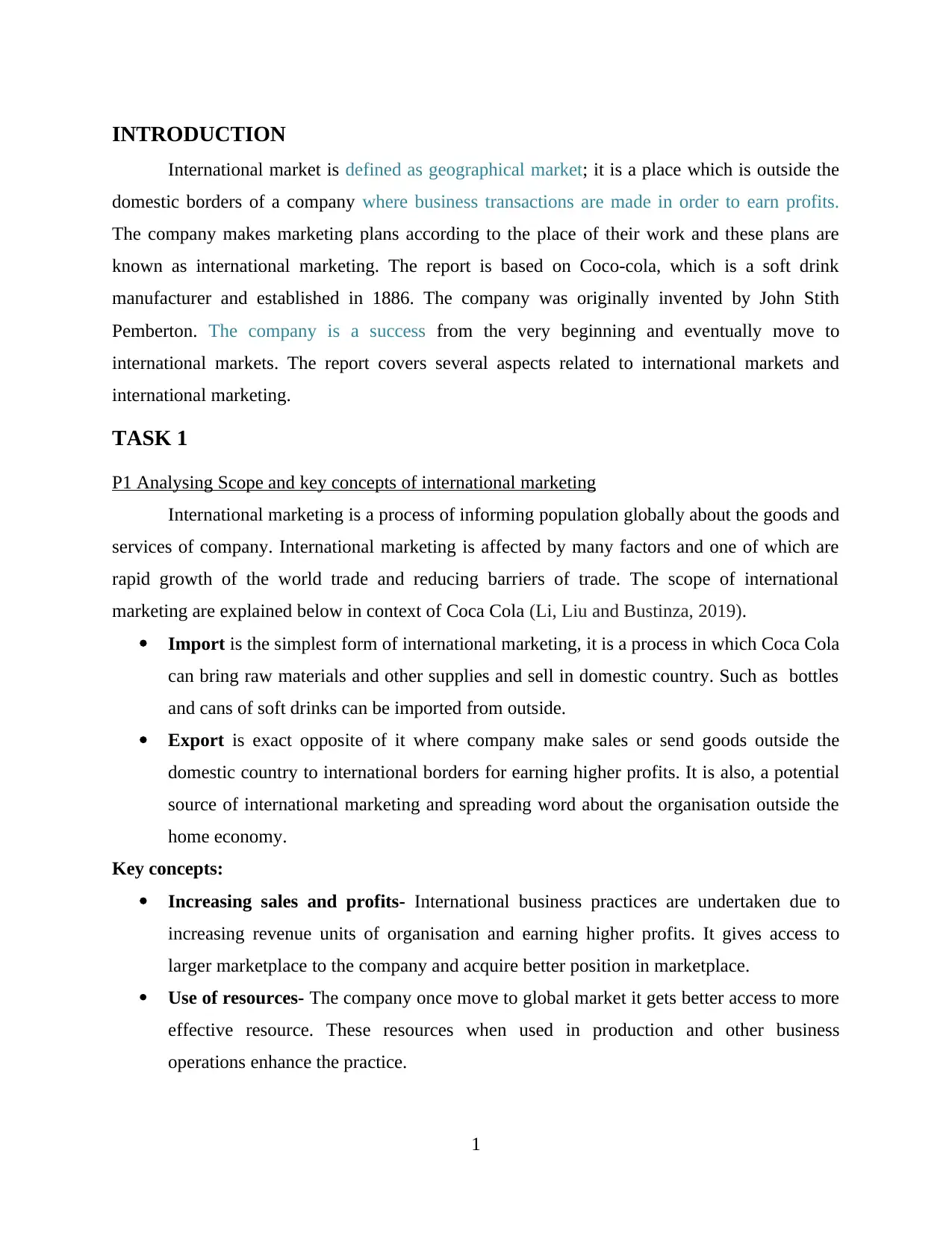
INTRODUCTION
International market is defined as geographical market; it is a place which is outside the
domestic borders of a company where business transactions are made in order to earn profits.
The company makes marketing plans according to the place of their work and these plans are
known as international marketing. The report is based on Coco-cola, which is a soft drink
manufacturer and established in 1886. The company was originally invented by John Stith
Pemberton. The company is a success from the very beginning and eventually move to
international markets. The report covers several aspects related to international markets and
international marketing.
TASK 1
P1 Analysing Scope and key concepts of international marketing
International marketing is a process of informing population globally about the goods and
services of company. International marketing is affected by many factors and one of which are
rapid growth of the world trade and reducing barriers of trade. The scope of international
marketing are explained below in context of Coca Cola (Li, Liu and Bustinza, 2019).
Import is the simplest form of international marketing, it is a process in which Coca Cola
can bring raw materials and other supplies and sell in domestic country. Such as bottles
and cans of soft drinks can be imported from outside.
Export is exact opposite of it where company make sales or send goods outside the
domestic country to international borders for earning higher profits. It is also, a potential
source of international marketing and spreading word about the organisation outside the
home economy.
Key concepts:
Increasing sales and profits- International business practices are undertaken due to
increasing revenue units of organisation and earning higher profits. It gives access to
larger marketplace to the company and acquire better position in marketplace.
Use of resources- The company once move to global market it gets better access to more
effective resource. These resources when used in production and other business
operations enhance the practice.
1
International market is defined as geographical market; it is a place which is outside the
domestic borders of a company where business transactions are made in order to earn profits.
The company makes marketing plans according to the place of their work and these plans are
known as international marketing. The report is based on Coco-cola, which is a soft drink
manufacturer and established in 1886. The company was originally invented by John Stith
Pemberton. The company is a success from the very beginning and eventually move to
international markets. The report covers several aspects related to international markets and
international marketing.
TASK 1
P1 Analysing Scope and key concepts of international marketing
International marketing is a process of informing population globally about the goods and
services of company. International marketing is affected by many factors and one of which are
rapid growth of the world trade and reducing barriers of trade. The scope of international
marketing are explained below in context of Coca Cola (Li, Liu and Bustinza, 2019).
Import is the simplest form of international marketing, it is a process in which Coca Cola
can bring raw materials and other supplies and sell in domestic country. Such as bottles
and cans of soft drinks can be imported from outside.
Export is exact opposite of it where company make sales or send goods outside the
domestic country to international borders for earning higher profits. It is also, a potential
source of international marketing and spreading word about the organisation outside the
home economy.
Key concepts:
Increasing sales and profits- International business practices are undertaken due to
increasing revenue units of organisation and earning higher profits. It gives access to
larger marketplace to the company and acquire better position in marketplace.
Use of resources- The company once move to global market it gets better access to more
effective resource. These resources when used in production and other business
operations enhance the practice.
1
⊘ This is a preview!⊘
Do you want full access?
Subscribe today to unlock all pages.

Trusted by 1+ million students worldwide
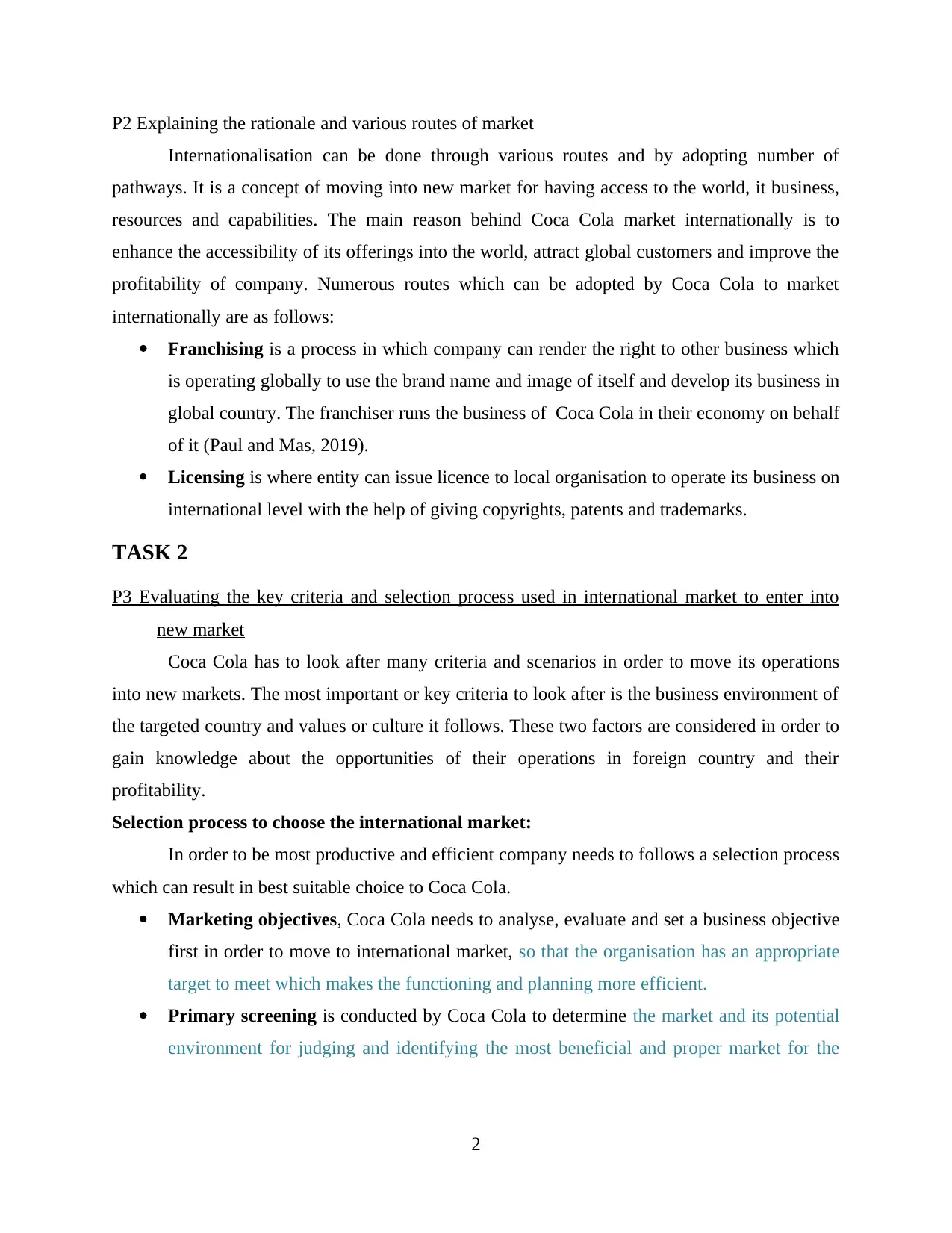
P2 Explaining the rationale and various routes of market
Internationalisation can be done through various routes and by adopting number of
pathways. It is a concept of moving into new market for having access to the world, it business,
resources and capabilities. The main reason behind Coca Cola market internationally is to
enhance the accessibility of its offerings into the world, attract global customers and improve the
profitability of company. Numerous routes which can be adopted by Coca Cola to market
internationally are as follows:
Franchising is a process in which company can render the right to other business which
is operating globally to use the brand name and image of itself and develop its business in
global country. The franchiser runs the business of Coca Cola in their economy on behalf
of it (Paul and Mas, 2019).
Licensing is where entity can issue licence to local organisation to operate its business on
international level with the help of giving copyrights, patents and trademarks.
TASK 2
P3 Evaluating the key criteria and selection process used in international market to enter into
new market
Coca Cola has to look after many criteria and scenarios in order to move its operations
into new markets. The most important or key criteria to look after is the business environment of
the targeted country and values or culture it follows. These two factors are considered in order to
gain knowledge about the opportunities of their operations in foreign country and their
profitability.
Selection process to choose the international market:
In order to be most productive and efficient company needs to follows a selection process
which can result in best suitable choice to Coca Cola.
Marketing objectives, Coca Cola needs to analyse, evaluate and set a business objective
first in order to move to international market, so that the organisation has an appropriate
target to meet which makes the functioning and planning more efficient.
Primary screening is conducted by Coca Cola to determine the market and its potential
environment for judging and identifying the most beneficial and proper market for the
2
Internationalisation can be done through various routes and by adopting number of
pathways. It is a concept of moving into new market for having access to the world, it business,
resources and capabilities. The main reason behind Coca Cola market internationally is to
enhance the accessibility of its offerings into the world, attract global customers and improve the
profitability of company. Numerous routes which can be adopted by Coca Cola to market
internationally are as follows:
Franchising is a process in which company can render the right to other business which
is operating globally to use the brand name and image of itself and develop its business in
global country. The franchiser runs the business of Coca Cola in their economy on behalf
of it (Paul and Mas, 2019).
Licensing is where entity can issue licence to local organisation to operate its business on
international level with the help of giving copyrights, patents and trademarks.
TASK 2
P3 Evaluating the key criteria and selection process used in international market to enter into
new market
Coca Cola has to look after many criteria and scenarios in order to move its operations
into new markets. The most important or key criteria to look after is the business environment of
the targeted country and values or culture it follows. These two factors are considered in order to
gain knowledge about the opportunities of their operations in foreign country and their
profitability.
Selection process to choose the international market:
In order to be most productive and efficient company needs to follows a selection process
which can result in best suitable choice to Coca Cola.
Marketing objectives, Coca Cola needs to analyse, evaluate and set a business objective
first in order to move to international market, so that the organisation has an appropriate
target to meet which makes the functioning and planning more efficient.
Primary screening is conducted by Coca Cola to determine the market and its potential
environment for judging and identifying the most beneficial and proper market for the
2
Paraphrase This Document
Need a fresh take? Get an instant paraphrase of this document with our AI Paraphraser
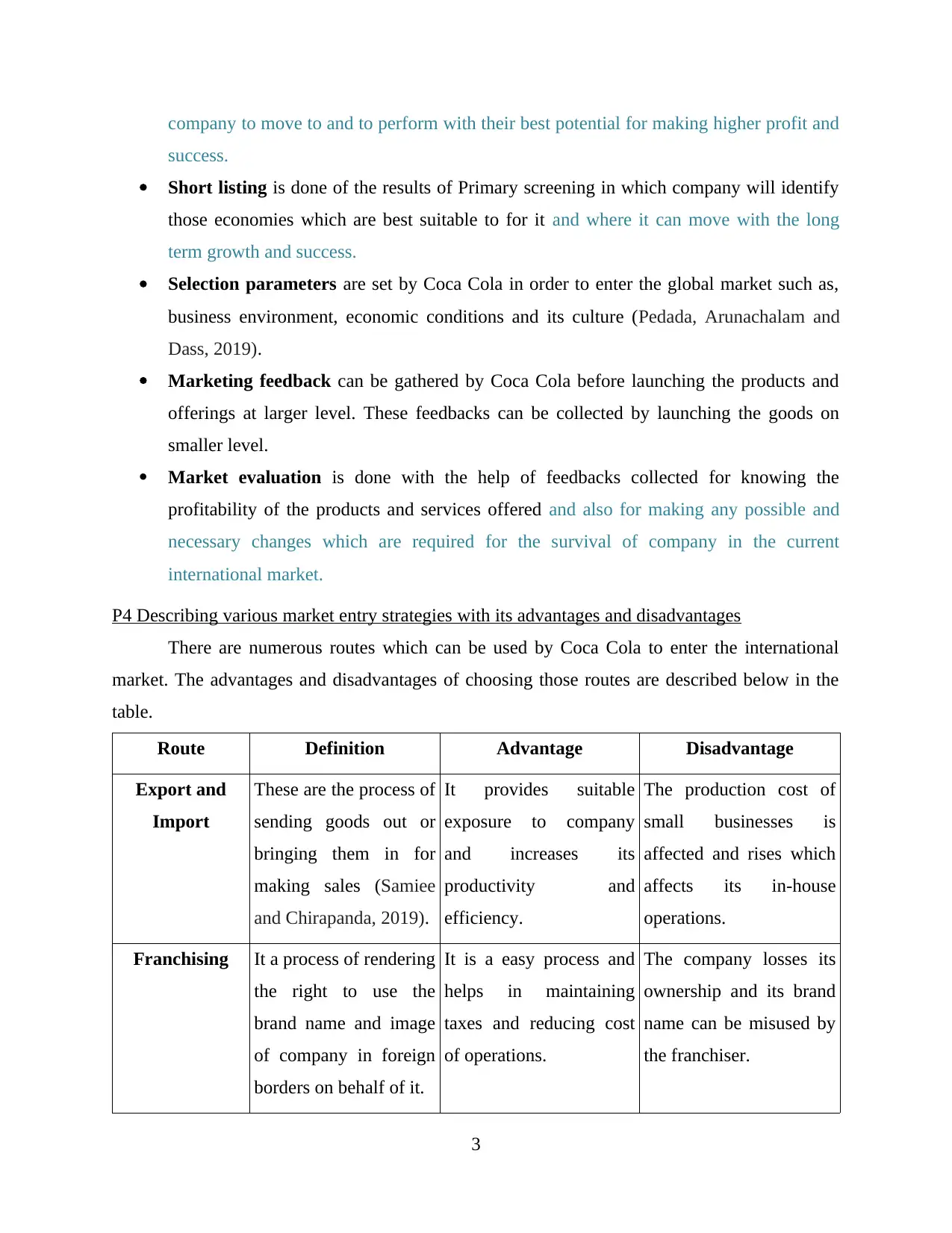
company to move to and to perform with their best potential for making higher profit and
success.
Short listing is done of the results of Primary screening in which company will identify
those economies which are best suitable to for it and where it can move with the long
term growth and success.
Selection parameters are set by Coca Cola in order to enter the global market such as,
business environment, economic conditions and its culture (Pedada, Arunachalam and
Dass, 2019).
Marketing feedback can be gathered by Coca Cola before launching the products and
offerings at larger level. These feedbacks can be collected by launching the goods on
smaller level.
Market evaluation is done with the help of feedbacks collected for knowing the
profitability of the products and services offered and also for making any possible and
necessary changes which are required for the survival of company in the current
international market.
P4 Describing various market entry strategies with its advantages and disadvantages
There are numerous routes which can be used by Coca Cola to enter the international
market. The advantages and disadvantages of choosing those routes are described below in the
table.
Route Definition Advantage Disadvantage
Export and
Import
These are the process of
sending goods out or
bringing them in for
making sales (Samiee
and Chirapanda, 2019).
It provides suitable
exposure to company
and increases its
productivity and
efficiency.
The production cost of
small businesses is
affected and rises which
affects its in-house
operations.
Franchising It a process of rendering
the right to use the
brand name and image
of company in foreign
borders on behalf of it.
It is a easy process and
helps in maintaining
taxes and reducing cost
of operations.
The company losses its
ownership and its brand
name can be misused by
the franchiser.
3
success.
Short listing is done of the results of Primary screening in which company will identify
those economies which are best suitable to for it and where it can move with the long
term growth and success.
Selection parameters are set by Coca Cola in order to enter the global market such as,
business environment, economic conditions and its culture (Pedada, Arunachalam and
Dass, 2019).
Marketing feedback can be gathered by Coca Cola before launching the products and
offerings at larger level. These feedbacks can be collected by launching the goods on
smaller level.
Market evaluation is done with the help of feedbacks collected for knowing the
profitability of the products and services offered and also for making any possible and
necessary changes which are required for the survival of company in the current
international market.
P4 Describing various market entry strategies with its advantages and disadvantages
There are numerous routes which can be used by Coca Cola to enter the international
market. The advantages and disadvantages of choosing those routes are described below in the
table.
Route Definition Advantage Disadvantage
Export and
Import
These are the process of
sending goods out or
bringing them in for
making sales (Samiee
and Chirapanda, 2019).
It provides suitable
exposure to company
and increases its
productivity and
efficiency.
The production cost of
small businesses is
affected and rises which
affects its in-house
operations.
Franchising It a process of rendering
the right to use the
brand name and image
of company in foreign
borders on behalf of it.
It is a easy process and
helps in maintaining
taxes and reducing cost
of operations.
The company losses its
ownership and its brand
name can be misused by
the franchiser.
3
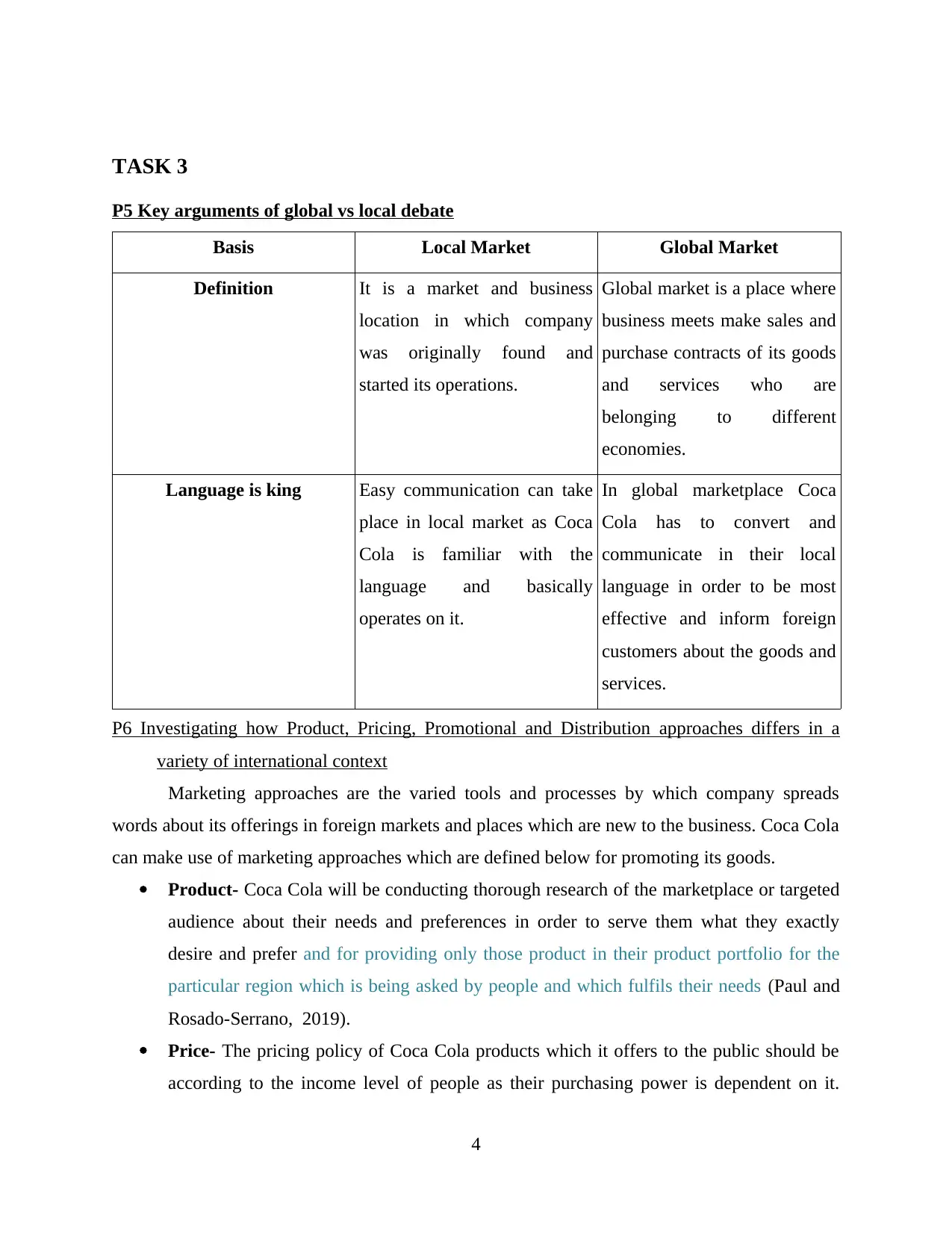
TASK 3
P5 Key arguments of global vs local debate
Basis Local Market Global Market
Definition It is a market and business
location in which company
was originally found and
started its operations.
Global market is a place where
business meets make sales and
purchase contracts of its goods
and services who are
belonging to different
economies.
Language is king Easy communication can take
place in local market as Coca
Cola is familiar with the
language and basically
operates on it.
In global marketplace Coca
Cola has to convert and
communicate in their local
language in order to be most
effective and inform foreign
customers about the goods and
services.
P6 Investigating how Product, Pricing, Promotional and Distribution approaches differs in a
variety of international context
Marketing approaches are the varied tools and processes by which company spreads
words about its offerings in foreign markets and places which are new to the business. Coca Cola
can make use of marketing approaches which are defined below for promoting its goods.
Product- Coca Cola will be conducting thorough research of the marketplace or targeted
audience about their needs and preferences in order to serve them what they exactly
desire and prefer and for providing only those product in their product portfolio for the
particular region which is being asked by people and which fulfils their needs (Paul and
Rosado-Serrano, 2019).
Price- The pricing policy of Coca Cola products which it offers to the public should be
according to the income level of people as their purchasing power is dependent on it.
4
P5 Key arguments of global vs local debate
Basis Local Market Global Market
Definition It is a market and business
location in which company
was originally found and
started its operations.
Global market is a place where
business meets make sales and
purchase contracts of its goods
and services who are
belonging to different
economies.
Language is king Easy communication can take
place in local market as Coca
Cola is familiar with the
language and basically
operates on it.
In global marketplace Coca
Cola has to convert and
communicate in their local
language in order to be most
effective and inform foreign
customers about the goods and
services.
P6 Investigating how Product, Pricing, Promotional and Distribution approaches differs in a
variety of international context
Marketing approaches are the varied tools and processes by which company spreads
words about its offerings in foreign markets and places which are new to the business. Coca Cola
can make use of marketing approaches which are defined below for promoting its goods.
Product- Coca Cola will be conducting thorough research of the marketplace or targeted
audience about their needs and preferences in order to serve them what they exactly
desire and prefer and for providing only those product in their product portfolio for the
particular region which is being asked by people and which fulfils their needs (Paul and
Rosado-Serrano, 2019).
Price- The pricing policy of Coca Cola products which it offers to the public should be
according to the income level of people as their purchasing power is dependent on it.
4
⊘ This is a preview!⊘
Do you want full access?
Subscribe today to unlock all pages.

Trusted by 1+ million students worldwide
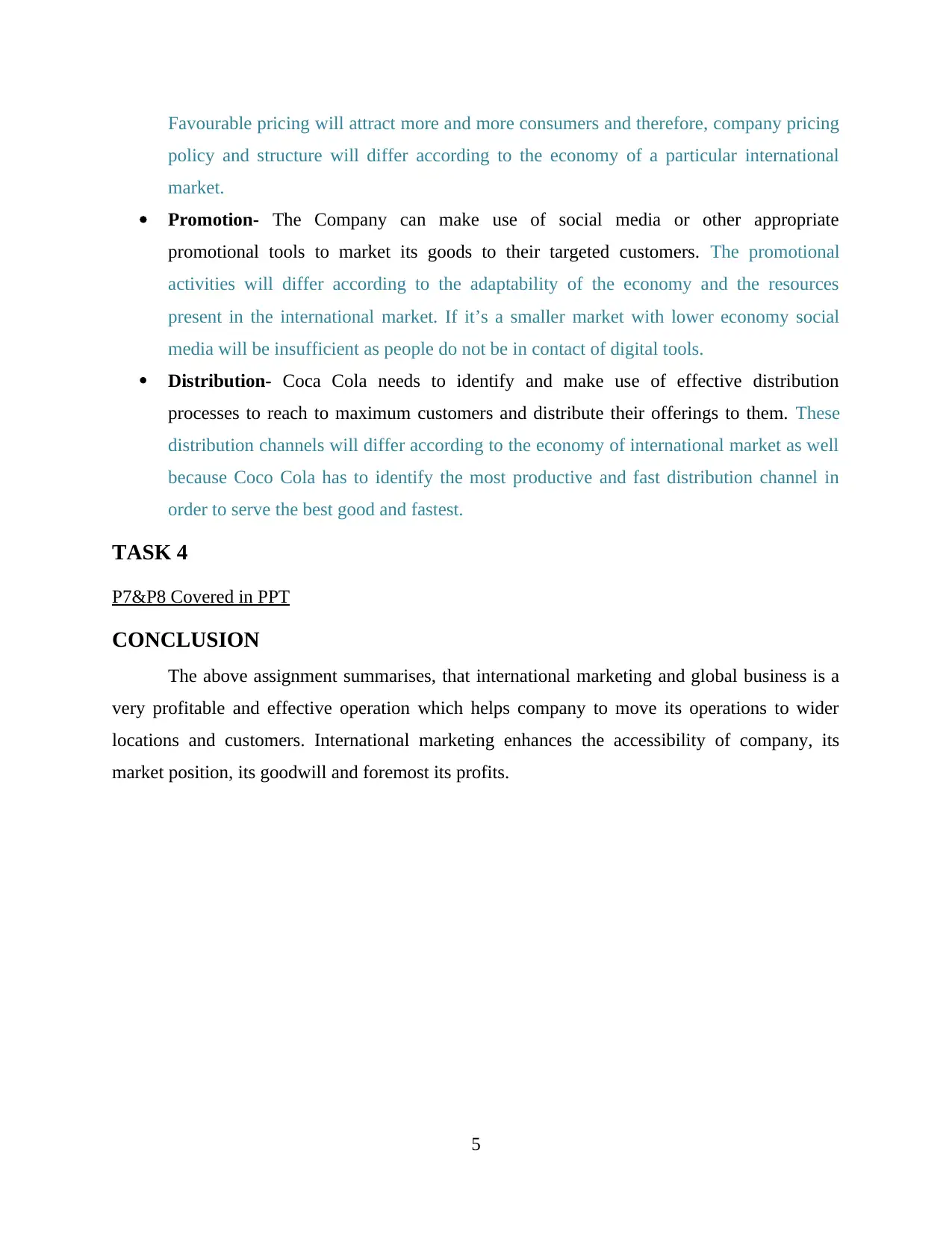
Favourable pricing will attract more and more consumers and therefore, company pricing
policy and structure will differ according to the economy of a particular international
market.
Promotion- The Company can make use of social media or other appropriate
promotional tools to market its goods to their targeted customers. The promotional
activities will differ according to the adaptability of the economy and the resources
present in the international market. If it’s a smaller market with lower economy social
media will be insufficient as people do not be in contact of digital tools.
Distribution- Coca Cola needs to identify and make use of effective distribution
processes to reach to maximum customers and distribute their offerings to them. These
distribution channels will differ according to the economy of international market as well
because Coco Cola has to identify the most productive and fast distribution channel in
order to serve the best good and fastest.
TASK 4
P7&P8 Covered in PPT
CONCLUSION
The above assignment summarises, that international marketing and global business is a
very profitable and effective operation which helps company to move its operations to wider
locations and customers. International marketing enhances the accessibility of company, its
market position, its goodwill and foremost its profits.
5
policy and structure will differ according to the economy of a particular international
market.
Promotion- The Company can make use of social media or other appropriate
promotional tools to market its goods to their targeted customers. The promotional
activities will differ according to the adaptability of the economy and the resources
present in the international market. If it’s a smaller market with lower economy social
media will be insufficient as people do not be in contact of digital tools.
Distribution- Coca Cola needs to identify and make use of effective distribution
processes to reach to maximum customers and distribute their offerings to them. These
distribution channels will differ according to the economy of international market as well
because Coco Cola has to identify the most productive and fast distribution channel in
order to serve the best good and fastest.
TASK 4
P7&P8 Covered in PPT
CONCLUSION
The above assignment summarises, that international marketing and global business is a
very profitable and effective operation which helps company to move its operations to wider
locations and customers. International marketing enhances the accessibility of company, its
market position, its goodwill and foremost its profits.
5
Paraphrase This Document
Need a fresh take? Get an instant paraphrase of this document with our AI Paraphraser
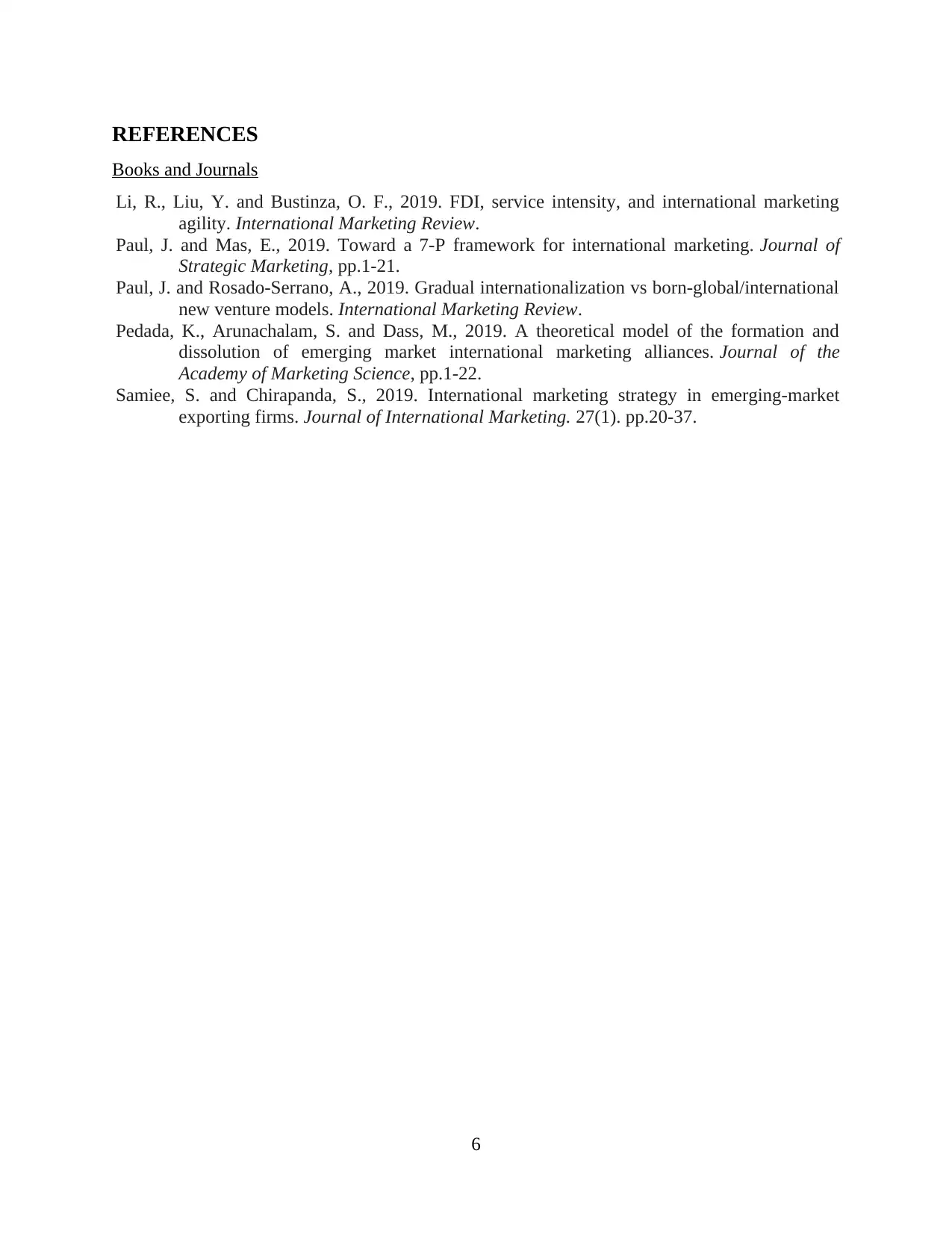
REFERENCES
Books and Journals
Li, R., Liu, Y. and Bustinza, O. F., 2019. FDI, service intensity, and international marketing
agility. International Marketing Review.
Paul, J. and Mas, E., 2019. Toward a 7-P framework for international marketing. Journal of
Strategic Marketing, pp.1-21.
Paul, J. and Rosado-Serrano, A., 2019. Gradual internationalization vs born-global/international
new venture models. International Marketing Review.
Pedada, K., Arunachalam, S. and Dass, M., 2019. A theoretical model of the formation and
dissolution of emerging market international marketing alliances. Journal of the
Academy of Marketing Science, pp.1-22.
Samiee, S. and Chirapanda, S., 2019. International marketing strategy in emerging-market
exporting firms. Journal of International Marketing. 27(1). pp.20-37.
6
Books and Journals
Li, R., Liu, Y. and Bustinza, O. F., 2019. FDI, service intensity, and international marketing
agility. International Marketing Review.
Paul, J. and Mas, E., 2019. Toward a 7-P framework for international marketing. Journal of
Strategic Marketing, pp.1-21.
Paul, J. and Rosado-Serrano, A., 2019. Gradual internationalization vs born-global/international
new venture models. International Marketing Review.
Pedada, K., Arunachalam, S. and Dass, M., 2019. A theoretical model of the formation and
dissolution of emerging market international marketing alliances. Journal of the
Academy of Marketing Science, pp.1-22.
Samiee, S. and Chirapanda, S., 2019. International marketing strategy in emerging-market
exporting firms. Journal of International Marketing. 27(1). pp.20-37.
6
1 out of 8
Related Documents
Your All-in-One AI-Powered Toolkit for Academic Success.
+13062052269
info@desklib.com
Available 24*7 on WhatsApp / Email
![[object Object]](/_next/static/media/star-bottom.7253800d.svg)
Unlock your academic potential
Copyright © 2020–2025 A2Z Services. All Rights Reserved. Developed and managed by ZUCOL.




